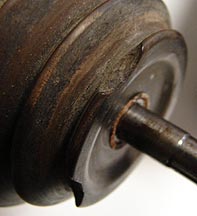
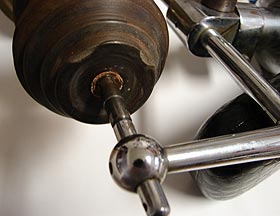
Repairing A Chipped WW Lathe Pulley
Copyright 2008 by James P. Riser
Chipped pulleys are a common problem on watchmaker
lathes and countershafts found on the used market. I ran across
a lathe, countershaft, motor, bench and assorted watchmaker/clockmaker
items at an antique shop and thought I would add the items to
my arsenal of machines. The cone pulley on the countershaft had
two chips on it. On this web page I shall show how I repaired
these chips in the hopes that the info will help others.
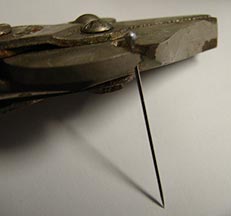 Step one was to
clip the head off of a straight pin.
This pin was then inserted into a pin vise to hold
it securely.
Step one was to
clip the head off of a straight pin.
This pin was then inserted into a pin vise to hold
it securely. 
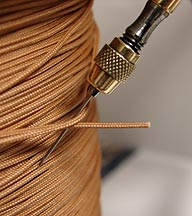 The idea I had in mind to repair the chips was to create
a type of fiber filler for the chips.
I have a large quantity of the polyester cording shown
here to use in certain items that I manufacture. This cording
was to be the fiber filler and was to prodide the strength for
the repairs to the chips.
Super glue was to be the resin to hold everything together
much like fiberglass.
The cut off pin was to assist in placing small strips
of the cording into position and to keep my fingers out of the
super glue.
Below are shown three steps in filling the chips with
the cording. The cording was placed into position then a drop
or two of super glue was applied. The pin held the cording strip
in position until the super glue set up. I added as many layers
of the cording/super glue as needed to fill up the space within
the two chips. The right hand image shows how things looked when
I felt the chips were filled.
The idea I had in mind to repair the chips was to create
a type of fiber filler for the chips.
I have a large quantity of the polyester cording shown
here to use in certain items that I manufacture. This cording
was to be the fiber filler and was to prodide the strength for
the repairs to the chips.
Super glue was to be the resin to hold everything together
much like fiberglass.
The cut off pin was to assist in placing small strips
of the cording into position and to keep my fingers out of the
super glue.
Below are shown three steps in filling the chips with
the cording. The cording was placed into position then a drop
or two of super glue was applied. The pin held the cording strip
in position until the super glue set up. I added as many layers
of the cording/super glue as needed to fill up the space within
the two chips. The right hand image shows how things looked when
I felt the chips were filled.
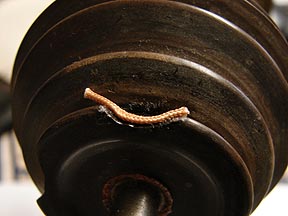
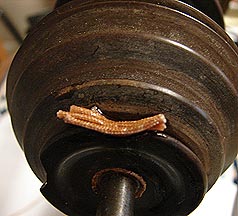
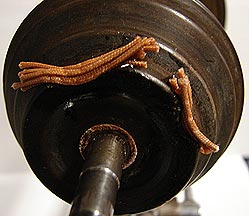
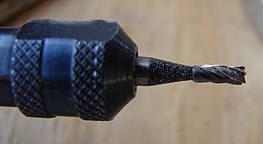 A Dremel tool with
the bit shown here was used to roughly trim away the extra cording.
A Dremel tool with
the bit shown here was used to roughly trim away the extra cording.
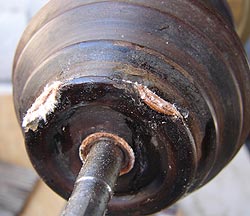 This is how the
pulley looked after the rough trimming.
This is how the
pulley looked after the rough trimming. 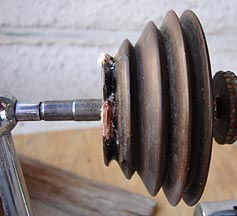 The trimmed patches became "fuzzy" during
this trimming and more super glue was applied to bind everything
together.
The trimmed patches became "fuzzy" during
this trimming and more super glue was applied to bind everything
together.
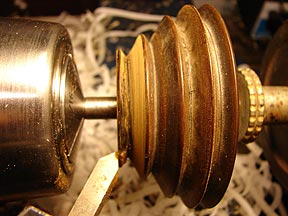
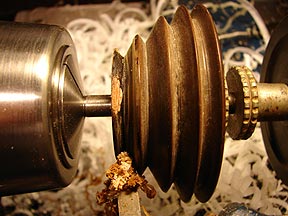 I then mounted the countershaft on my Sheldon lathe
to clean up the repair job.
The "V" groove was machined to match the
others on the pulley.
And the end of the pulley was also cleaned up.
During the process, the repairs got "fuzzy"
again. More super glue was applied to bind any loose fiber edges.
I then mounted the countershaft on my Sheldon lathe
to clean up the repair job.
The "V" groove was machined to match the
others on the pulley.
And the end of the pulley was also cleaned up.
During the process, the repairs got "fuzzy"
again. More super glue was applied to bind any loose fiber edges.
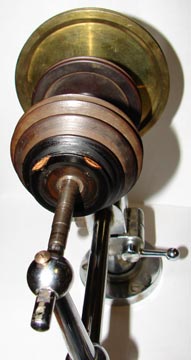
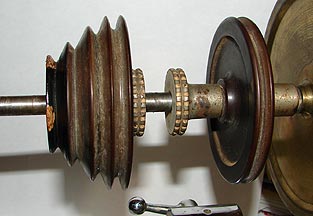 The repaired pulley now looks like this and is once
again a very useable pulley.
The repairs are visible due to differences in color.
A little leather dye could be used to hide the color differences;
but I am more concerned with the nice countershaft being a working
part of the lathe drive system.
The repaired pulley now looks like this and is once
again a very useable pulley.
The repairs are visible due to differences in color.
A little leather dye could be used to hide the color differences;
but I am more concerned with the nice countershaft being a working
part of the lathe drive system.




 Step one was to
clip the head off of a straight pin.
Step one was to
clip the head off of a straight pin.




 A Dremel tool with
the bit shown here was used to roughly trim away the extra cording.
A Dremel tool with
the bit shown here was used to roughly trim away the extra cording. This is how the
pulley looked after the rough trimming.
This is how the
pulley looked after the rough trimming. 



